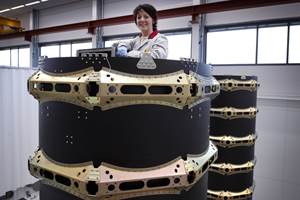Schuler composite press in operation at National Composites Centre
This press is producing parts within less than five minutes.
The U.K.'s National Composite Centre (NCC, Bristol, U.K.), which works to help develop innovative composite solutions, has put into operation a Schuler press for high-volume manufacturing of composites.
The upstroke short-stroke press has a press force of 36,000 kN and a clamping surface of 3.6 x 2.4 m. “We have installed the world’s largest openly accessible high rate manufacturing press for composites,” said NCC Business Development Director Tom Hitchings. “This is aimed at supporting sectors such as automotive, where developing high rate, low-cost manufacture of composite components is critical. This press is producing parts within less than five minutes.”
The NCC uses the HP-RTM process (High Pressure Resin Transfer Molding) in which carbon fiber fabrics are placed in a die, filled with resin and hardened by applying heat and the pressure of the press. High-pressure RTM presses not only enable shorter cycle times for complex parts with high requirements regarding geometry and rigidity, but also deliver consistently high part and surface quality. This virtually eliminates voids, i.e. resin-free vacuum pores or gaps within the part or along its edges.
In the high-pressure RTM process, resin is injected as quickly and smoothly as possible into the vacuum mold which is opened by just a few tenths of a millimeter. This gap injection process enables the resin to spread over the mat with far less flow resistance and thus with low injection pressure. It then quickly infiltrates the mat before polymerization is started by heat induction.
The vacuum assistance, fast resin injection, high resin pressures and tempered dies mean that the gelling process virtually begins with the wetting of the last fiber. The thicker the part, the longer the curing. Depending on the part, the necessary resin pressures also vary between 60 and 150 bar.
Due to the geometry of the part or cavity surface, the die’s center of loading is not necessarily in the middle of the press. There are also off-center forces from the injection positions. The parallelism control prevents the slide or upper die from tilting during gap injection and thus ensures smooth and even injection over the entire surface.
Conventional downstroke machines work with a fixed bed and moving bolster, and a slide whose press force is transmitted via cylinders in the press crown. Parallelism is ensured by four servo-controlled counter-pressure cylinders located at the bed corners. These are also responsible for the break open force needed to counter the adhesive forces and open the die.
In the upstroke short-stroke press, the slide only acts as support during the pressing process. From top dead center, the slide is moved by a drive cylinder to its support position and locked there. The actual working stroke is performed by the bed plate, driven by several short-stroke cylinders. Parallelism is ensured by the servo controlling of these cylinders. The breakout force in upstroke presses is achieved by the withdrawal of the bed plate. The benefits of the upstroke short-stroke press compared to downstroke designs are the high closing speeds of 1,000 mm/s, the shorter pressure build-up times of under 0.3 s and the significantly lower construction height.
The NCC first presented the Schuler press to the public at the formal opening of its new facilities on October 30, 2014 ,which doubled the size of the centre. “The centre now has something for all businesses involved in composites manufacture, across all sectors,” Hitchings said. “Our open-access model provides a flexible approach to enable working with companies of all sizes – from SMEs to Tier 1s and large OEMs. We already have commitments from large and medium sized enterprises involved in renewable energy, aerospace, automotive, defense, marine and rail, and we expect this list to grow. With the addition of the new Schuler press, the NCC becomes a catalyst for real change in the industry.”
Related Content
RUAG rebrands as Beyond Gravity, boosts CFRP satellite dispenser capacity
NEW smart factory in Linköping will double production and use sensors, data analytics for real-time quality control — CW talks with Holger Wentscher, Beyond Gravity’s head of launcher programs.
Read MoreComposite resins price change report
CW’s running summary of resin price change announcements from major material suppliers that serve the composites manufacturing industry.
Read MoreNovel composite technology replaces welded joints in tubular structures
The Tree Composites TC-joint replaces traditional welding in jacket foundations for offshore wind turbine generator applications, advancing the world’s quest for fast, sustainable energy deployment.
Read MoreMaterials & Processes: Tooling for composites
Composite parts are formed in molds, also known as tools. Tools can be made from virtually any material. The material type, shape and complexity depend upon the part and length of production run. Here's a short summary of the issues involved in electing and making tools.
Read MoreRead Next
Composites end markets: Energy (2024)
Composites are used widely in oil/gas, wind and other renewable energy applications. Despite market challenges, growth potential and innovation for composites continue.
Read MoreCW’s 2024 Top Shops survey offers new approach to benchmarking
Respondents that complete the survey by April 30, 2024, have the chance to be recognized as an honoree.
Read MoreFrom the CW Archives: The tale of the thermoplastic cryotank
In 2006, guest columnist Bob Hartunian related the story of his efforts two decades prior, while at McDonnell Douglas, to develop a thermoplastic composite crytank for hydrogen storage. He learned a lot of lessons.
Read More

























